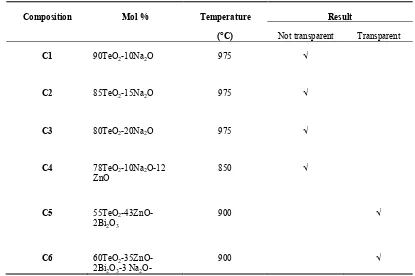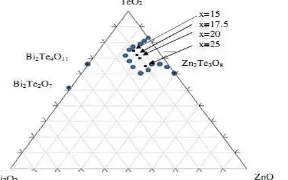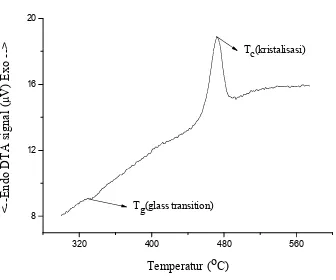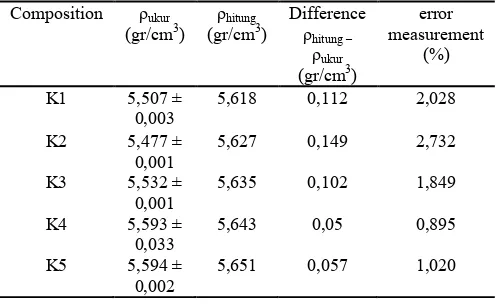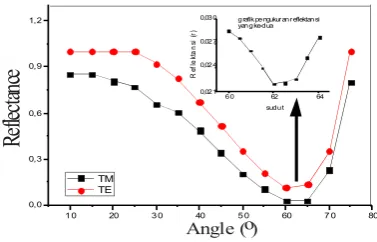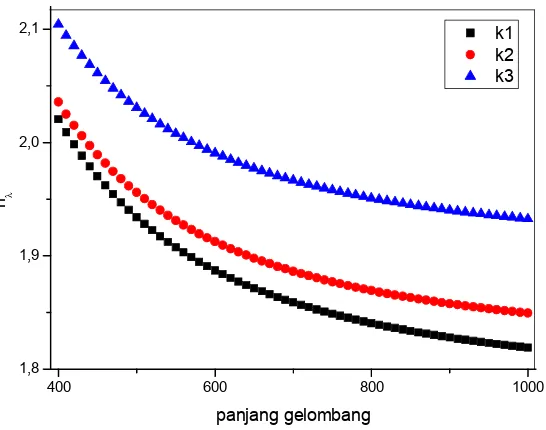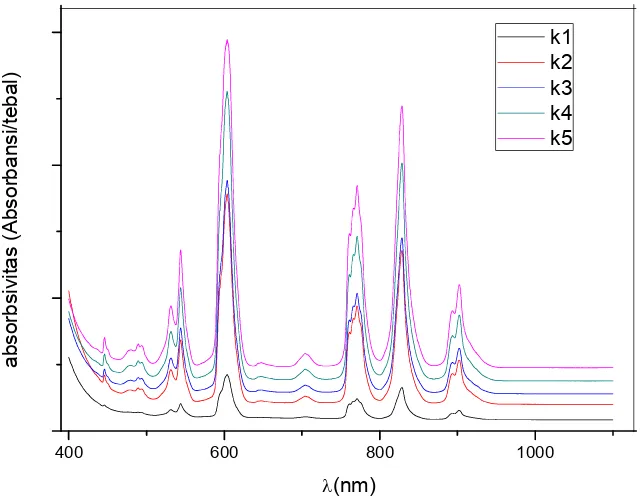Effect of Variation Consentration Ion Nd
3+on the
Physical and Optical Properties of TZBN Glasses
as a Host Material Glass Laser
Lita Rahmasari1, Ika Nurmalasari2, Riyatun2, Ahmad Marzuki2
1
Physics Education, Faculty of Teacher Training and Education. Sebelas Maret University
2
Physics, Faculty of Mathematics and Natural Sciences, Sebelas Maret University Email : [email protected]
Received 18-09-2012, Revised 02-10-2012, Accepted 04-10-2012, Published 29-10-2012
ABSTRACT
This study aims to determine the effect of Nd3+ion concentration on the physical and optical properties of tellurite glass. Tellurite glass used is TZBN (Tellurium Zinc Bismuth Natrium Oxide), with composition (mol%) 60TeO2-(35-x) ZnO-2Bi2O3-3Na2O, and x(Nd2O3) with
variation of x= 0.5; 1.0; 1.5; 2.0; 2.5 mol% as a doping. Fabrication is done by using the melt quenching method. The physical properties of glass density was measured using pycnometer. Absorption spectra of glass be learned using UV-VIS-NIR spectroscopy in the range 400 nm to 1100 nm. Refractive index values were measured using the method of Brewster angle at a wavelength of 632.8 nm and 532 nm. The result of characterization shows that the density index, refractive index and the optical absorption increase as the Nd3+ ions concentration doped to tellurite glasses.
Keywords : ion Nd3+concentration , TZBN, glass density
INTRODUCTION
Laser is one very important discovery in the development of science and technology. Laser solid (crystalline) e.g ruby laser was first discovered in 1960, while the laser glass (glass) in 1961. Glass laser has advantages over laser crystal, which is related to the glass structure irregularity. Most laser glass using lanthanide ions as an active. It is related to the coupling elements of earth history (rare earth) with host emits vibrations of non-radiative electron excitation level, and also improved quantum efficiency and emission levels.
measuring the absorbance using a spectrophotometer UV-Vis-NIR.The purpose of this study was to determine the effect of Nd3+ ion concentration on the physical and optical properties of glass, mainly related to the nature of the lasing properties of glass.
METHOD
The method used in this study is experimental methods. Fabrication of glass made using melt quenching method. TZBN glass (TeO2, ZnO, Bi2O3, Na2O) and Nd2O3 with initial
composition set weighed using analytical balance. Material then melted in a platinum cruicible. The results of the melt are then poured into a brass mold that has been heated by using a furnace at a temperature of 250oC. Annealing glass has been formed using the furnace. After that the glass sample was cut using a glass cutter and then dipolish. Glass then cleaned using alcohol.
Table 1.Composition and glass results
Characterization of glass on the study includes refractive index, density, and absorbance. Measurement of the refractive index values by using a spectrometer with the method of Brewster. Density of the samples is measured using Archimedes method of Pycnometer appropriate. While measuring the absorbance values is perfomed using a UV-Vis-NIR spectrophotometer.
RESULT AND DISCUSSION
Research fabricated glass with composition TeO2-ZnO-Na2O-Bi2O3-Nd2O3 melt
quenching method has been successfully carried out. The fabrication process of glass is made by melting the material in a furnace at a temperature of 900°C. While the glass molding process carried out at a temperature of 250°C, and annealing at a temperature of 370° C with a cooling rate of 2°C/min. In this study, the characterization of the study includes measurement of density, reflectance, refractive index and absorbance.
Composition Mol % Temperature
(°C)
Result
Not transparent Transparent
C1 90TeO2-10Na2O 975 √
C2 85TeO2-15Na2O 975 √
C3 80TeO2-20Na2O 975 √
C4 78TeO2-10Na2O-12
ZnO
850 √
C5 55TeO2
-43ZnO-2Bi2O3
900 √
C6 60TeO2
-35ZnO-2Bi2O3-3 Na2
Glass fabrication process is not always expected to obtain glass. In this research has been done several times fabricated with different compositions. This is done to obtain the appropriate composition for the glass. Initial composition is used as shown in Table 1.
According Mallawany et al[5], amorphous or crystalline phase in the glass can be seen from the properties of transparent glass. Materials that are transparent tellurite have an amorphous phase. While the solid phase of the material is non-transparent tellurite crystal phase.
C1 composition, temperature furnace set at 450°C (held for ± 1 hour) and 975°C (for ± 3 hours) without N2 gas flow. The use temperature of 450°C aims to outline material into
Na2O and CO2 Na2CO3[6]. Meanwhile, at a temperature of 975 °C is for the melting
process materials. On the composition of C2 and C3, the resulting physical glass and frosted orange, there are white spots, some parts of crystallized glass.
Composition C4 furnace temperature set at 400°C (held for ± 1 hour) and 850°C (for ± 2 hours) and N2 gas flowed at 3-4 l/m. Giving N2 gas in the furnace intended that the CO2
gas produced from the decomposition of materials Na2CO3no further reaction with Na2O.
Physically glass obtained from the same composition as the composition of C1. The addition of ZnO little to change in the resulting glass, the colors are not so dark.
Composition C5, when the melt temperature of 900°C and viscous orange nodes. The increase in the viscosity of the molten Bi2O3is caused by the use of materials that have a
high viscosity[7]. The results of clear glass are orange and crystallized.
Composition C6, the results obtained glass the color yellow, clear, no spots anymore. Based on glass obtained from this composition, the composition is used as a host for the by Nd2O3glass.
When fabricated glass, there are some factors affecting fabrication including the state of the furnace and the number of components or composition. Of these factors, the composition of the dominant factors in the formation of glass. As performed by Massera[7] in the fabrication of glass TeO2 - ZnO - Bi2O3, that not all glass compositions produce
glass, only in certain areas of the phase diagram. This can be seen in the phase diagram shown in Figure 1.
Figure 1.Phase diagrams for the TeO2 - ZnO - Bi2O3[7]
Table 2.The composition of the tellurite glass fabrication doped Nd3+ions
Composition Mol %
TeO2 ZnO Bi2O3 Na2O Nd2O3
K1 60 34,5 2 3 0,5
K2 60 34 2 3 1,0
K3 60 33,5 2 3 1,5
K4 60 33 2 3 2,0
Based on the composition of the C6, the composition of which is used in the manufacture of TZBN glass that were doped Nd3+ ions as shown in Table 2. The fabrication process done after the material has been prepared using the mixed chalice and mortar. Mixing the ingredients aimed at homogenizing the material. Fabrication begins by inserting the material into a heated platinum cruicible furnace with a temperature of 900°C for 1 hour. Furnace will start working with the increase in temperature will fluctuate and is stable at a temperature that has been set. When it has reached the desired maximum temperature, the temperature is still fluctuating temperature rise of 1°C to 3°C.
By the time the temperature has stabilized, then do mixing ingredients. Stirring was repeated at a maximum temperature stable for ± 30 minutes. This is done to remove air bubbles and to improve the homogenization of the melt by convection and inter-diffusion of constituent atoms. If there are air bubbles in the glass, the furnace temperature was raised to 950°C to remove air bubbles.
If the mixing process has been done, the next step is the process of molding glass. In this process, the temperature used will affect the crystal growth rate and nucleation rate. Nucleation can occur homogeneously in the formation of spontaneous fusion. And it may also occur heterogeneously on surfaces such as the formation of the impurity and wall cruicible and others. If it does not happen then nucleate crystal growth does not occur and the material will form a glass. Therefore the melt quenching method is used to prevent crystallization. In this method, a viscous liquid at high temperatures cooled rapidly at room temperature. However, to avoid a crack in the glass, mold preheated at a temperature of 250°C.
Table 3.Tellurite glass density measurement
data were doped Nd3+ions
The formation of crystals in the glass can also be avoided by keeping the glass viscosity level. In this use case Bi2O3 compound because it has a relatively large mass of the
compound. Bi2O3compounds can also decrease the thermal stability against crystallization
and can increase the viscosity of the glass[8]. So that the molten glass did not crystallize when the printing process. High viscosity levels greatly affect the cooling process and the formation of glass.
Figure 2.Tellurite glass samples were doped Nd3+ions
Composition Nd3+
concentration in glass (x1021
atom)
densityρ (gr/cm3)
K1 0,3 5,507 ± 0,003
K2 0,6 5,477 ± 0,001
K3 0,9 5,532 ± 0,001
K4 1,2 5,593 ± 0,033
320 400 480 560
The observed color of the glass changes from bright yellow to purplish pink as Nd3+ ion concentration increases as shown in Figure 2. Staining the glass sample was generated from Nd3+ ions into the glass host material, so that allows absorption at specific wavelengths within the visible spectrum. The addition of rare earth ions is color variation effect when irradiated with different wavelengths.
Glasses have been formed as shown in Figure 2. Glass obtained was then annealed at a temperature of 370°C for 6 hours and cooled with colling rate of 2°C/min until it reaches room temperature. Annealing performed intended for glass constituent atoms can diffuse evenly, thus forming a tight uniformity substance on the glass.
Annealing temperatures used are glass transition temperature close to the temperature. Glass transition temperature, Tg the glass known from DTA curves, as shown in Figure 3. Glass transition temperature, Tg is the temperature at which a glass undergoes a transformation from a rigid solid becomes supercooled and very viscous liquid. Glass transition point is an important characteristic of the glass because it represents the nature of the upper temperature limit in which a glass can be used.
Based on Figure 3, it is known that the crystallization appears at a certain temperature above the glass transition temperature, Tg (320-360°C) and below the melting point, Tm (> 560°C). So the annealing temperatures used in this study is a temperature 370°C, because at this temperature is close to the glass transition temperature and away from the beginning of the crystallization temperature (450°C).
Characterization
Characterization of glass is made after annealed glass, cut and optically polished (smoothed). In this study, the characterization of glass covers the characterization of physical properties and optical properties.
Characterization of physical properties
Characterization of physical properties of glass is used for the measurement of density. The magnitude of the density of the glass can be done by the fabrication method of Archimedes. Glass density measurements carried five times for each composition. The results of the calculation are given in Table 3.
However, the addition of 1.0 mol% by Nd3+ions (K2) and the reduction of 1 mol% ZnO, the measured density is lower and lower levels of homogeneity are also compared with the addition of 0.5 mol% ion bye Nd3+ (K1). This could be due to the fabrication process and annealing glass, so the level of uniformity in the composition of substances meeting is low.
Reduction of ZnO on the structure of tellurite causes structural rearrangement of atoms. The reduction will result in increased zinc ion molar volume of glass, so the glass interatomic distances increase as well. Thus, the density of the glass will fall [9] and the diffusion process Nd3+ ions into the structure of tellurite glass network becomes easier. In addition, the compound Na2O with high phonon energy will produce a large atomic
vibration and the resulting interatomic distances were also getting bigger.
Density of each constituent compound Nd glass:tellurite among others, TeO2 of 5.670
g/cm3 (tetragonal) and 6.04 g/cm3 (orthorombik), ZnO of 5.606 g/cm3, 8.90 g/cm3 for Bi2O3 in form powder, Na2O 2.27 g/cm3 density, and Nd2O3 of 7.24 g/cm3[10]. Based on
the density values of each compound, the glass density values can be estimated with a theoretical approach given by the following equation[11]:
(1)
Where ρ is the density, VA, VB, VC is the volume fraction in the emissions per unit of mass. The results of theoretical calculations are shown in Table 4. Based on Table 4, the theoretical calculation results are not much different from the results, as error measurements obtained are still below 5%.
Table 4.Validation results of density measurements by predictions of the theory (Equation 1)
Characterization of the optical properties of glass
Reflectance and refractive index g rafik pe ngukur an r eflektan si yan g ke-dua
Figure 4.(color online) The results of reflectance measurements on samples of K2
In principle, the glass is transparent to light in the wavelength region where the intrinsic absorption does not occur. Common intrinsic absorption is electron transition energies and vibrational energy[12]. So it can be said that a good glass has high ability in transmitting light. The ability to transmit high light reflectance value is indicated by the small. Corner with a small reflectance values or when the angle of incidence and refraction angles approaching 90° is called the polarization angle or Brewster’s angle.
Measuring the value of the index of materials is done by measuring the reflectance values first using a spectrometer with Brewster angle method. In the first stage, corner angles varied from 10° to 75° intervals of increase of 5°. The second phase, reflectance values taken at the reflection angle range between 60° to 65° with the TM polarized light as in-show in Figure 4. Basic measurements of refractive index values using a range of angles to minimize the interval of (5/60)°. Measurement of the refractive index will be done with a variety of wavelengths of light sources, such as the red laser (632.8 nm) and green laser (532 nm).
From the resulting data, the data taken with the smallest reflectance value, the angle is commonly called the polarization angle or Brewster angles. Value of the refractive index at a wavelength of 632.8 nm and 532 nm as shown in Figure 5 increased from 1.8764 to 2.1128 with increasing concentrations of Nd3+ ion. The results of measurements with a wavelength of 532 nm also showed the same results as the wavelength of 632.8 nm. Figure
5 also shows that the refractive index of the function λ has decreased in each of the
400 600 800 1000 1,8
1,9 2,0
2,1 k1
k2 k3
n
panjang gelombang
Figure 6.(color online) Graph showing the relationship n withλas a result of interpolation refractive index data using the equation Couchy the sample K1, K2, and K3
According to[13], the value of the refractive index of a material is influenced by several factors, namely the electron density, polarizability, density and thermal expansion glass. The use of ZnO materials in tellurite glass affect on the bonding of oxygen in the glass. With the substitution between ZnO into the TeO2, relationships (bridging) bond Te-O-Te
bonds break and Te-O-Zn2+ unrelated (non-bridging)[5,14]. Non-bridging oxygen bonds have a high anion polarizability[14]. Anion polarizability increases in emissions would result in increasing the electron cloud and increasing electron density. When the electron density is large, then the light will experience more collision, the speed of light creeping into small and the refractive index increases.
On the other hand, the effect of the addition of Nd3+ ion concentration is equal to the reduction of ZnO compound in increasing the refractive index but in a different mechanism. The addition of Nd3+ ions on the structure directs the formation of a more densely packed with rare earth modifier into the host material [15]. This has a direct effect on the increase in the refractive index, because the glass is proportional to the density or refractive index. Finger Nd3+ ions are small (1.123 Å) will increase with increasing refractive index Nd3+ ion concentration. Figure 6 shows the interpolation value of refractive index with λ function.
Absorbance
Absorbance measurements in this study using UV-Vis spectrophotometer in the wavelength range 400 nm to 1100 nm. Optical absorption spectrum of the tellurite glass were doped Nd3+ions at room temperature is shown in Figure 7.
Based on Figure 7, it can be seen that the transmitted light at wavelengths between 950 nm and 1100 nm. While the absorption occurs in the wavelength range 350 nm to 950 nm. Highest uptake for each - each composition occurs at a wavelength of about 600 nm. Glass absorbsivitas value increases with Nd3+ion concentration. It can be seen from each of the absorption peaks for each sample. For the purpose in view of the difference in scale, the y-axis in Figure 7 has been shifted by 2 cm-1.
Figure 7.(color online) Tellurite glass optical absorptivities are doped ions Nd3 +ions
REFERENCES
1 Choi J.H. and Shi. F.G. Spectral Properties of Nd3+ Ion in New Flourophosphates Glasses: Judd Ofelt Intensity Parameter. Department of Chemistry Technical and Material Science, Univesity of California, pp. 10 – 29
2 Marzuki, A. 2007. Laser Analysis of Nd3+ Ion in Flouroaluminat Glasses. Jurnal Matematika dan Sains. Vol. 12, No.1, pp. 32-37
3 Jiang, L.I., Yang Zhi-Yong, Wu Yu-Song, Liu Wen-Bin, Pan Yu-Bai1, Huang Li-Ping, Guo Jing-Kun. 2008. Spectroscopic Properties And Judd Ofelt Theory Analysis Of Nd:YAG Transparent Laser Cheramic. Journal of Inorganic Materials. Vol 23, No.3, pp. 429-432
4 Zhang. J., Shixue Dai, Guonion Wang, Shiqing Xu, Liyun Zhang, Lili Hu. 2004. Spectroscopic Properties of Neodymium-Doped Tellurite Glass Fiber. Chinese Optics LettersVol 2 No.9, pp. 540 - 548
5 Mallawany, R. El. 2002. Tellurite Glasses Handbook: Physics Properties and Data. London : CRC press, pp. 372
6 Verheijen, O.S. 2003. Thermal And Chemical Behavior Of Glass Forming Batches. Universitas Eindhoven-ISBN 90-386-2555-3
7 Massera, J. 2009. Nucleation And Growth Behavior Of Tellurite Based Glasses Suitable For Mid Infrared Applications. Thesis of the Graduate School Clemson University, pp. 21 - 253
8 Suri. N., Bindra. K.S., Kumar. P., Kamboj. M.S., Thangaraj.R.2006. Thermal Investigations Ion Bulk Se(80-x) Te2OBi x Chalcogenide Glass. Journal of Ovonic ResearchVol 2 No 6 , pp. 111-118
9 Saddeek, Y.B., 2005. Elastic Properties of Gd3+-Doped Tellurovanadate Glasses Using Pulse-Echo Technique.Journal of Material Chemistry and Physics, 91, pp. 146-153. 10 Brady, G., Clauser. S., Henry. R., Vaccari, John. A. 2002. Materials HandbookEd.15.
New York: McGraw-Hill Professional, pp. 100 – 150
11 Meliegy, E and Noort. R.V. 2012. Glasses And Glass Ceramics For Medical Applications. London: Springer Science And Business Media
12 Yamane, M and Asahara. Y. 2000. Glasses For Photonics. Cambridge University press, pp. 54-60
13 Shelby, J. E 1997. Introduction to Glass Science and Technology. London: The Royal Society Of Chemistry, Herts, pp. 22 – 23
14 Eraiah, B. 2006. Optical Properties Of Samarium Doped Zinc Tellurite Glasses. Jurnal Bull Material ScienceVol.29 No. 4, pp. 375-378
15 Mallawany, R. El., Dirar A. M., Ahmed. I.A. 2008. New Tellurite Glass:Optical Properties.Journal of Material Chemistry and Physics109, pp. 291-296
16 Fusari, F. 2010. Continuous wave and Modelocked femtosecond novel bulk glass lasers operating around 2000 nm. Thesis Submitted for the Degree of PhD University of St. Andrews Skotlandia, pp. 25-35
